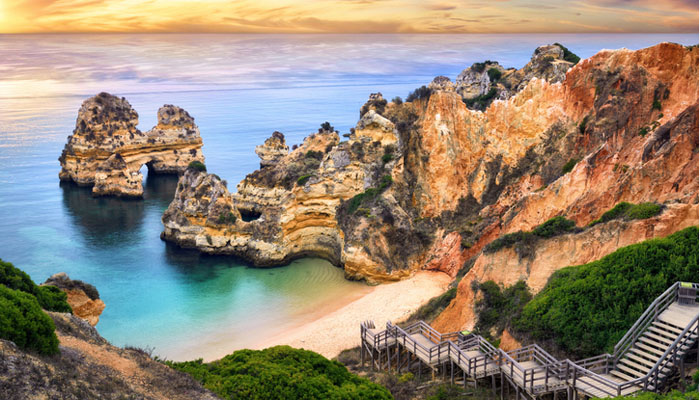One of the least well-known and most surprising coasts on the Iberian Peninsula is the Portuguese Algarve. Although the area is famous in terms of tourism, there’s more than meets the eye. Exploring more deeply can take us much further, which is why we think you should take a break there. A holiday of 4 – 7 days would be perfect to dive into its seas and discover some of its most charming corners. Will you join us?
The geographic location of the Algarve grants it many hours of sunshine in summer and a hypnotising topography that intersperses high cliffs with fine, sandy coves. Along the coasts there are calm stretches and giant waves, which means you’ll be equally at home whether you’re fishing or enjoying water sports, which are common on the western coast.
Culturally speaking, Portugal, just like neighbouring Spain, shows a strong Arabic influence following eight centuries of occupation. That goes for the Algarve as well, but that’s not to say that you can’t see lots of its own personality, manifested in its culture, architecture, food, and more.
The name, Algarve, comes from the Arabic al-Garb, which literally means “The West” (from garb al-Andalus, to the west of Al Andalus, now Andalucia, which once included the south of Portugal).
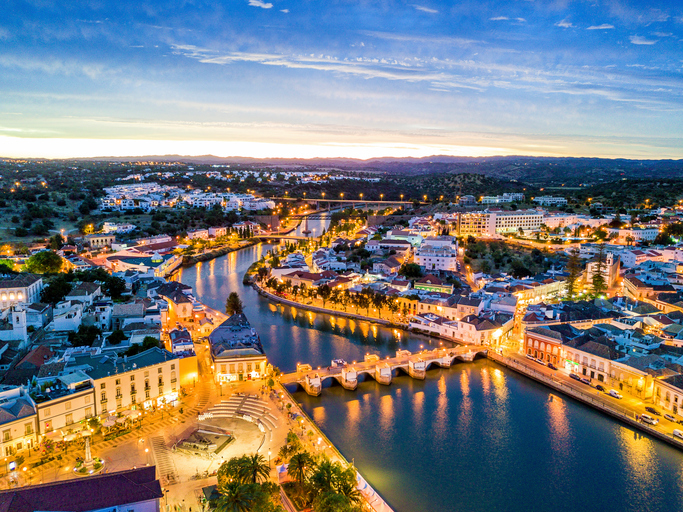
Let’s start in the east
If we’ve arrived by plane, it will be to Faro airport, and from there or having crossed Andalusian lands, we will follow a route from east to west.
The first stop we suggest is Cacela Velha, a small town beside the sea. Its charm and serenity stems from both its squat blue-trimmed houses, as well as its stunning views of the Parque Natural de la Ría Formosa natural park.
The park stretches along the coast and covers more than 18,000 hectares, protected from the sea by the five “barrier islands”, Isla Barreta or Isla Desierta, Isla de Culatra, Isla de Armona, Isla de Tavira and Isla de Cabanas, and two peninsulas, Cacela or Isla de Faro, and Ancão.
Soon, we’ll turn off for Tavira, an area where we can really get a feel for the peculiarities of the zone, with narrow streets, and 2-storey houses on tiny alleys adorned in hand-painted tiles. The town is luminous during the day and animated at night, thanks to markets and folklore festivals that go on all summer.
At the coast, Tavira enjoys huge, beautiful beaches, some of the most impressive being Praia Do Barril, which we get to riding an old train that runs along the estuary, or Praia da Ilha de Tavira, an island beach which you can get to on a little boat across the channel.
The fishing village Olhao is in the same zone. You’ll want to take a walk around it to get to know the traditional port area or take a small boat to discover more of the islets that make up the labyrinthine Ría Formosa. Any of the genuine seafood restaurants on the main avenue are great places to eat. You’ll have the chance to taste a delicious seafood rice, or the local cataplanas or dishes made in a cataplana, a hinged cooking dish typical of the region.
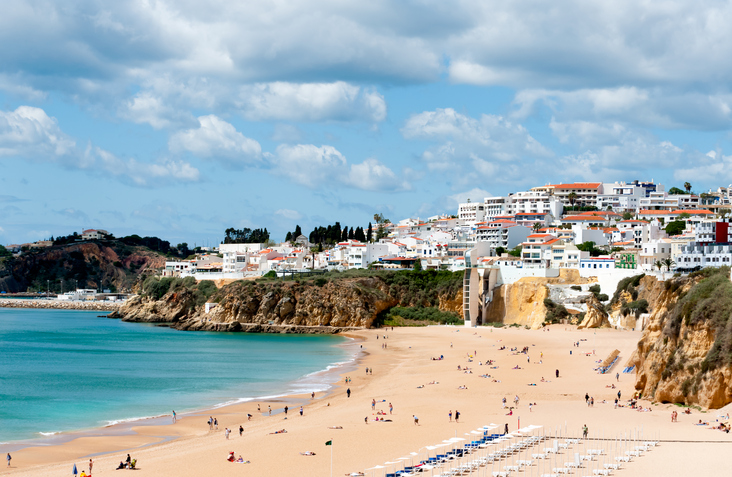
A little further west you’ll find two charming towns in a row – Faro and a little further, Albufeira. Both have an Algarve-flavoured old town, complete with beautiful squares and emblematic historical buildings, as well as bearing witness to the growth that the sun and sea tourism has brought to the area in the form of huge tourist complexes. You can choose to get lost wandering around the tangle of corners and backstreets in the old town or check out the renovated souvenir shops. If you’re serious about what you’re taking back home, however, we recommend that you check out the timetable for upcoming markets selling more authentic handicrafts.
After taking a break on one of Albufeira’s main beaches, Praia dos Pescadores or Praia do Peneco, our next stop is Armançao de Pera, home to FIESA, or the international sand festival, a great place to check out with kids. It has been installed from March to November for the last 15 years, and we recommend visiting at dusk, when you can still see the sculptures, but the lighting makes the vast exhibition even more magical.
If you’re looking for a little more excitement, especially once night falls, you can head over to Portimao and Praia da Rocha, areas filled with terraces, bars and clubs and a full offering of activities directed at the young and energetic.
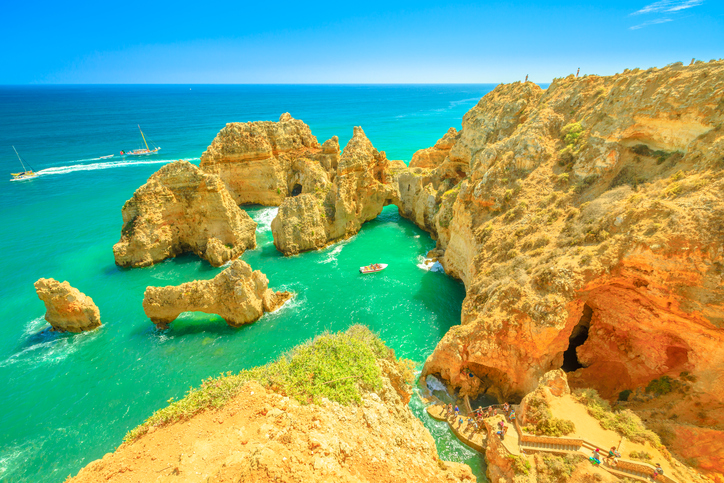
To the west of the Algarve
Over the last few days of our trip, we’ll visit the west coast of the Algarve. The first town we come across is Lagos, a small, historical city with a marine past and a tourism present. It has beautiful squares and buildings and is close to Ponta da Piedade, a range of exceedingly beautiful cliffs and one of the most impressive coastal landscapes in Portugal.
Although there are some great views of the cliffs from the top, you’ll need to go down to the beach or sea to truly appreciate the magnitude of its beauty. We recommend getting down onto beaches like Pinhao, Dona Ana or Camilo using the steps, or booking a boat or kayak trip for the day, letting you explore the capricious grottoes, caves, and natural arches that the wind and sea have carved into the rock.
Our last stop on the west coast is Sagres, a small town that offers an alternative tourism much sought after by surfers and their friends. Although the beaches closest to the town are busy and young, like Beliche and da Mareta, the real surfing action takes place along the coast to the north, on beaches like Ponta Ruiva, Cordoama, Amado or the vast Bordeira.
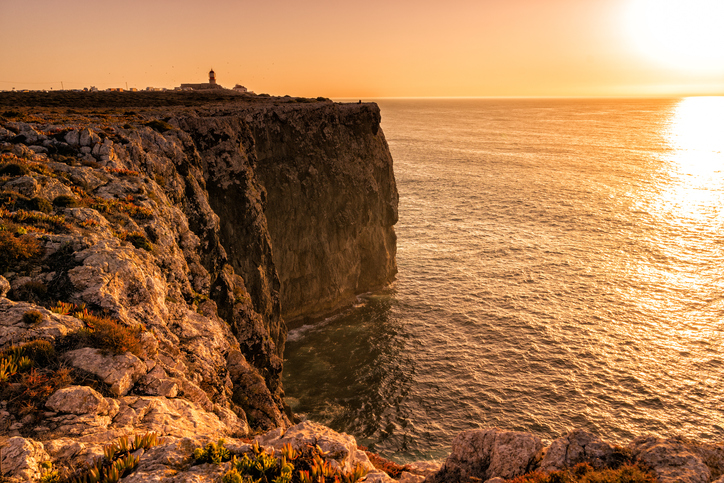
If the days in the area are marvellous, then the nights are unforgettable. Contemplate dramatic sunsets from la Fortaleza and el Faro de Sagres looking out over Cabo San Vicente. As long as you wrap up well against the strong winds in the area, it’s a feast for the senses.
To end your last day and your trip, if you’ve got any energy left, see the holiday out with a dance at any of the live music venues along the main avenue in Sagres.
As you might be thinking, there’s more to the Algarve than meets the eye. It’s a great place for almost any kind of holiday, because without crossing into the realm of mass tourism, it seems to be able to offer a solution or option for any kind of visitor, no matter what you’re looking for.



